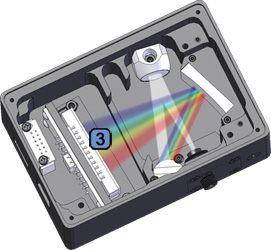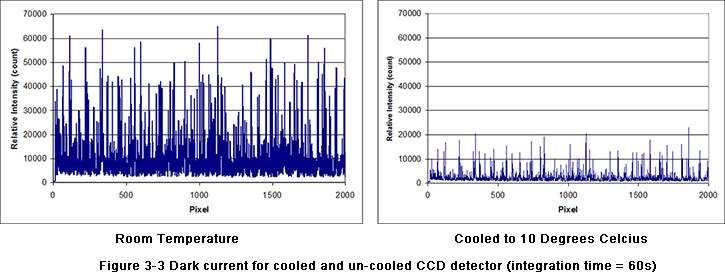Part 3b: The Detector
Overview
In Part 3a, we discussed several different types of detectors and the role they play in miniature spectrometers. No discussion of detectors would be complete without covering noise sources and how they can be mitigated by the use of TE Cooling.
Detector Noise:
 The main noise sources found in an array detector include: readout noise, shot noise, dark noise, and fixed pattern noise.
The main noise sources found in an array detector include: readout noise, shot noise, dark noise, and fixed pattern noise.
Readout noise is caused by electronic noise in the detector output stage and related circuitry, which largely dictates the detection limit of the spectrometer.
Shot noise is associated with the statistical variation in the number of photons incident on the detector, which follows a Poisson distribution. Therefore, shot noise is proportional to the square root of the incident photon flux.
Dark noise is associated with the statistical changes in the number of electrons generated in a dark state. A photo detector exhibits a small output even when no incident light is present. This is known as the dark current or dark output. Dark current is caused by thermally generated electron movements and is strongly dependent on ambient temperatures. Similar to shot noise, dark noise also follows a Poisson distribution; as a result, dark noise is proportional to the square root of the dark current.
The fixed pattern noise is the variation in photo-response between neighboring pixels. This variation results mainly from variations in the quantum efficiency among pixels caused by non-uniformities in the aperture area and film thickness that arise during fabrication.
The total noise of an array detector is the root square sum of these four noise sources.
TE Cooling:
Cooling an array detector with a built-in thermoelectric cooler (TEC) is an effective way to reduce dark noise as well as to enhance the dynamic range and detection limit. For Si detectors, dark current doubles when the temperature increases by approximately 5 to 7°C and halves when the temperature decreases by approximately 5 to 7°C. Figure 3-3 shows the dark noise for an un-cooled and cooled CCD detector at an integration time of 60s. When operating at room temperature, the dark noise nearly saturates the un-cooled CCD. When the CCD is cooled down to only 10°C by the TEC, the dark current is reduced by about four times and the dark noise is reduced by about two times. This makes the CCD capable of operating at a longer integration time to detect weak optical signals. When a CCD based spectrometer is involved in non-demanding high light level applications such as LED measurement, the dark noise reduction due to TE cooling is minimal because of the relatively short integration time used.

As a rule of thumb, when the integration time of a CCD spectrometer is set to less than 200ms, the detector is operating in a read noise limited state. Therefore, there is no significant noise reduction due to the TE cooling; although the temperature regulation under these conditions will be beneficial for long term baseline stability.
Browse our extensive line of spectrometers.
Browse our spectrometer accessory line.
Submit your questions using the “Request Quote or Info” button above, or call us at (302) 368-7824.







